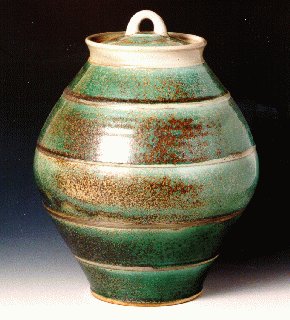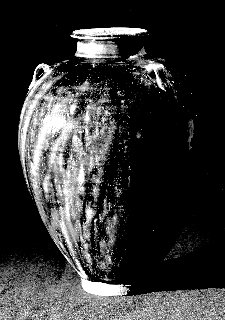Mark ShapiroThe pots I most admire - whether they be great Asian stonewares from the Song China, Yi Korean pots, Japanese folk pottery, early american saltware, old jugs from la Borne, France, to the pots of Leach, Hamada and their followers - were made in great quantities by potters who worked every day and fired large wood-burning kilns. I follow this practice myself, not as a formula for making good pots, but because it is the best way I can see to make comptemporary pots which have power, presence and purpose. I make pots with soft clay on a treadle wheel, and some larger pieces on a stand-up electric wheel. I like to manimpulate the clay as it dries and changes character by faceting, paddling, texturing and carving. I use kaolin slips and a few glazes - a saturated copper, two iron, and shino liner. the pots are fired with salt in a large, two-chambered kiln, maintaining a neutral to oxidizing atmosphere during the twenty hour firing cycle. | 
|

|
Willi Singleton
My pots are mostly kickwheel thrown and fully glazed. I make my glazes primarily from materials coming from the surrounding area-- creek clay, wood ash, and corn stalk ash, but I also use feldspar, kaolin and two oxides from the ceramic supply house. Making pots is a little like cooking. You have to start with good ingredients to get a flavorful, satisfying result. By using local clays and various ashes I am trying to make pots which have a pleasing flavor. Using a wood flame to fire these pots enhances the character of these materials. Although there are not many obvious ash deposits on my pots, the variety of colors and textures in them are largely due to the wood flame interacting with the clay and glaze materials, just as food cooked over an open fire carries a taste of the flame and smoke. Working with natural materials and with the unpredictability of firing in a 400 cubic foot wood kiln, I am always surprised when I open the kiln. There are good reasons to continue woodfiring in this day and age. Woodfiring does different things to pots, compared to other types of firing. It won't turn a bad pot into a good pot, but there's a chance that it will turn a good pot into a great pot. By using a wood flame and natural clays and ashes, I believe there is a possibility of attaining a deeper and more subtle beauty. That's what keeps me going. |